Salmon Fishing With Leeches: Are Leeches A Good Bait?
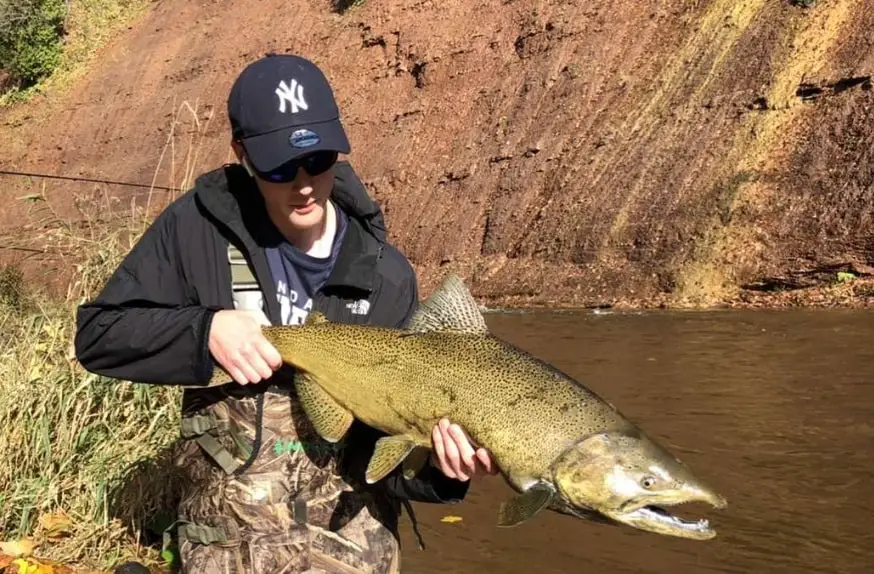
Have you ever heard of guys salmon fishing with leeches? I’m talking about live leeches and not the leech imitation flies that many guys use.
Having been an experienced guide for salmon for over 20 years, and an avid angler for over 35 years, I’ve experimented with just about all bait options that are commonly used for salmon fish and some not-so-common baits. Salmon fishing with live leeches or other small aquatic creatures is a lesser-known bait that deserves attention.
I’ve had good success with leeches when targeting steelhead and trout, so it made me wonder if leeches could be just as effective for salmon fishing.
As a guide who spends around 300 days a year on the water, I’ve had ample opportunities to test leeches under various conditions and during different stages of the salmon runs. So do salmon eat leeches, and is salmon fishing with leeches something you should consider? Let’s find out.
In their natural habitat, salmon frequently pursue small aquatic creatures like leeches. Therefore, it’s reasonable to assume that they would readily take a well-presented leech as they migrate up a river to spawn. In fact, many fly angler use leech imitation flies like woolly buggers and Egg Sucking Leeches with excellent results.
There are different types of leeches that I tested out for salmon fishing.
Salmon Fishing With Leeches
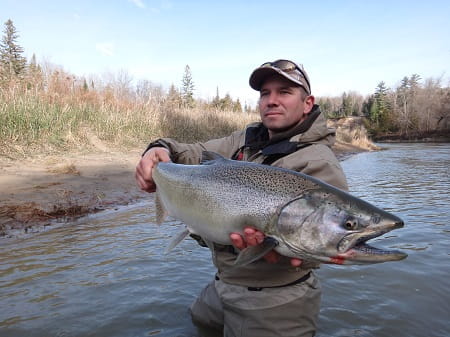
Leeches are commonly recognized as small aquatic creatures and based on my tests, they are indeed effective as bait for salmon fishing.
Some anglers enhance their effectiveness by adding scents or attractants to the leeches, but I don’t normally do this since my testes did not conclude that doing so worked better.
Some anglers even use leeches in combination with beads or other baits, this is something that I do with good results.
Please ensure that the regulations in your area permit using leeches as bait and that you are permitted to use two or more baits.
Do Leeches Truly Work as Bait for Salmon Fishing?
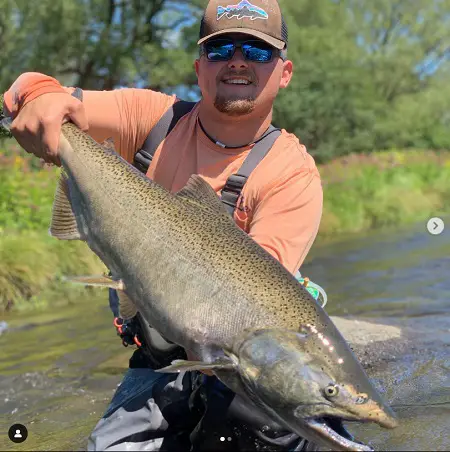
Through various experiments, I’ve tested different leeches and used different rigging techniques.
I’ve used both live and preserved leeches, including salted and vacuum-packed options. I’ve also experimented with artificial leeches like the GULP Leech.
Surprisingly, I’ve caught salmon using all of these types of leeches as bait. I’ve conducted numerous tests in different conditions and found leeches to be effective for both wild and stocked salmon.
However, before you dismiss other bait options and solely rely on leeches, there are essential factors to consider.
Salmon, known for their intelligence, are opportunistic feeders and often strike at a range of baits, including non-food items. Nevertheless, natural baits like leeches can trigger a strike response in salmon.
Moreover, when an object drifts near a salmon in fast currents, the fish may instinctively grab it due to the limited time it has to inspect the bait.
In slower or stagnant water bodies where salmon have ample time to inspect the bait, the effectiveness of leeches is also goos especially live leeches that are trying to swim.
The action of the swimming leech can trigger a strike from passing salmon.
In conclusion, leeches do work, but to what extent? Their effectiveness is debatable, especially when compared to other baits. Let’s explore this further.
Rigging Leeches for Salmon Fishing
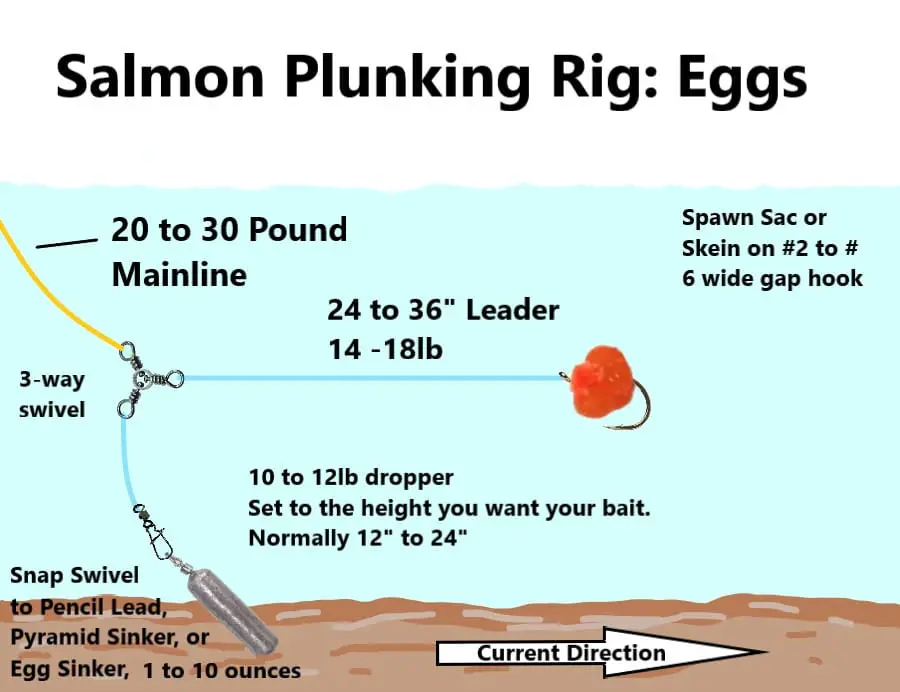
I generally use a size 8 or 10 Raven Specimen or Gamakatsu hook and hook the leech once in the head as close to the mouth as possible.
I try to put the hook into the mouth or sucker of the leech.
Doing so won’t kill the leech and it allows the leech to swim. The swimming action is a trigger for salmon.
I’ll also rig my leech on a sep the same way I use spawn sacs, and other baits
Size Of Leeches For Salmon Fishing
When it comes to the size of the leeches, I’ve found that leeches ranging from 4 to 5 inches work well. In murkier or higher water, larger leeches tend to attract more bites.
Conversely, smaller leeches are worth a try in low and clear water with current or when dealing with spooked salmon.
Methods for Fishing Salmon with Leeches
There are several effective methods that I use when salmon fishing with leeches.
Bottom Fishing or Plunking For Salmon With Leeches
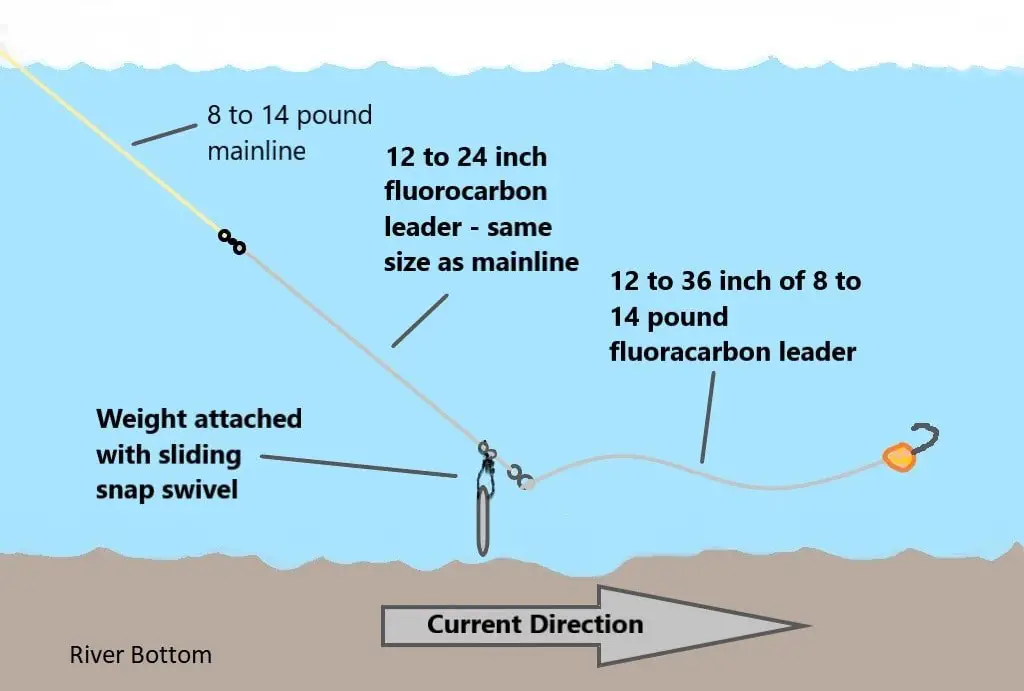
When using the stationary rig known as the bottom rig or plunking rig, cast your line and allow the bait to sink to the riverbed or bottom of the area you’re fishing.
Maintain a slightly slack line to give the salmon an opportunity to swim with the bait. Keep a close eye on your rod tip and the line.
If you notice any movement or the line starts to pull out, it’s likely a bite. In such cases, close the bail and set the hook firmly.
Use a floating bead about 12 inches from the leech to keep the leech off the bottom and I often use a leader about 30 inches.
Float Fishing With Leeches
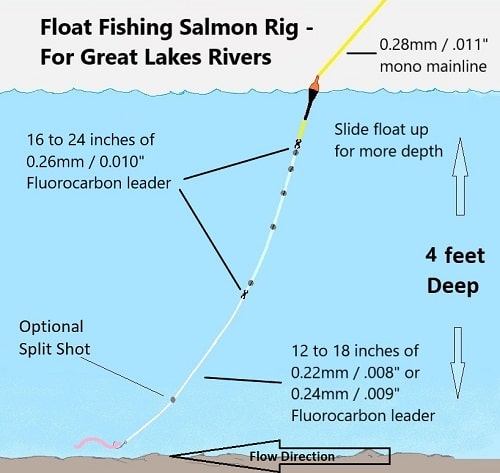
Float fishing is often an incredibly effective method for fishing with leeches in rivers.
When fishing in still or deep water, use a slip float to facilitate easy casting and achieve the optimal depth.
In rivers or water less than 12 feet deep, a stationary float is my preferred choice. Instead of using round bobbers, opt for pencil-style or thin-style floats like the Raven FM float, which is highly regarded by many experienced guides and anglers.
Let the leeche drift slowly down the river with the current. I try to keep the leech about 2 feet off the river bottom.
Advanced Tips and Techniques For Catching Salmon With Leeches
To increase your salmon catch rates when using leeches, consider the following tips:
Proper Hook Baiting: Always thread the hook through the leech in a way that ensures the hook point is exposed. This significantly improves your chances of a successful hookset when the salmon strikes.
Reducing Line Visibility: Salmon have sharp vision and can detect fishing leaders, especially thicker ones. Opt for a fluorocarbon leader around 12 to 14 pounds, as it is less visible underwater and can improve your success rate. You may need to increase or decrease your leader size depending on the type of water you fish.
Weather Considerations: Salmon tend to be more active during overcast weather, early mornings, or late evenings. Fishing during these periods can increase your chances of success.
Fishing at the Correct Depth: Salmon typically swim about 1 to 3 feet from the riverbed. Position your bait at this depth to attract salmon. Using a floating bead to suspend the leeches off the river bottom at the right height can be effective.
Adding Scent: Some anglers enhance the attractiveness of their bait by incorporating commercially available scents or substances like garlic oil.
Fish With A Bead Combination: I will peg a colorful hard or soft bead 2 to 4 inches up the line. This can attract the salmon and get more bites. At times, I’ll even put the bead touching the hook.
Good Hooks: You must use extra strong hooks, there are very sharp and are also wide gap and short shank. These are the salmon hooks that will improve your hook-up and landing of big salmon.
Comparing Leeches to Other Salmon Baits
While leeches have their place in the salmon bait scene, they may not match up to other baits in terms of success rates. While it can be an interesting experiment to use leeches, consistent catches with them are less common compared to other baits.
Although some anglers swear by leeches, it’s challenging to determine if they yield equal or better results compared to proven baits like spawn bags or worms.
Exploring High-Percentage Baits for Optimal Results
To improve your chances of catching more salmon or the most salmon possible, it’s advisable to rely on baits that have a proven track record and consistently attract salmon.
Professional guides often prefer baits that have a high success rate, even when dealing with selective or cautious fish, such as larger and more wary wild salmon.
There are various effective baits you can use for salmon fishing, including worms, skein, fish eggs sacs, shrimp, flies, insects, and grubs.
Based on my findings, brighter baits generally tend to work better for salmon and for this reason, I tend to use them a lot more than I would leeches. Spawn bags, skein, beads, and egg flies are among the baits that have proven consistent effectiveness. I delve into these options and more on my page: “10 Best Salmon Baits: How and When to Use Them.”
Are Leeches Good or Bad for Salmon Fishing? The Verdict
Based on my personal experience, I wouldn’t solely rely on leeches as the primary bait for salmon fishing, particularly when guiding clients. However, there have been instances where leeches have proven to be effective and saved the day.
The drawback of using leeches is the effort involved in acquiring, storing, and carrying them while on the river.
Should You Use Leeches for Salmon Fishing?
In my view, leeches can be a viable additional bait option when other, more reliable baits are not producing the desired results.
However, I wouldn’t recommend them as the primary choice. It’s always advisable to use baits that have a high success rate and are trusted by professional guides.
Do Salmon Guides Use Leeches?
I do not know of any other salmon guides that use leeches, however, that does not mean that they don’t. I just can’t say for sure. Maybe some other salmon guides will comment below on their experiences with leeches for salmon fishing.
Salmon Fishing with Leeches: Q&A
If you have any questions, insights, or advice regarding salmon fishing with leeches, feel free to share them in the comments section below.
Tight Lines,
Graham
